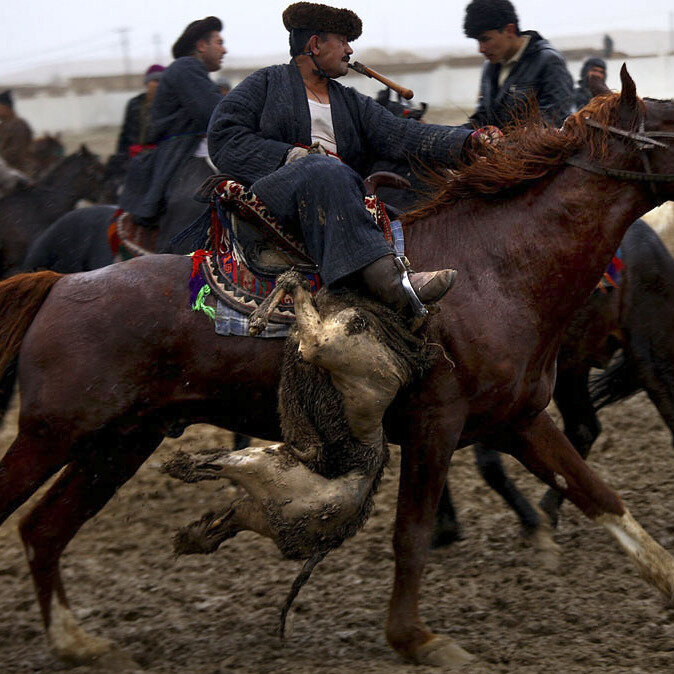Buzkashi: Polo with a Goat Carcass in Central Asia
Imagine a vast, open field surrounded by the rugged landscapes of Central Asia. In this arena, a unique and adrenaline-pumping sport unfolds, one that combines elements of skill, tradition, and sheer daring. This is Buzkashi, a traditional equestrian sport played in various Central Asian countries, where riders on horseback vie for control of a goat carcass. As unusual as it may sound, Buzkashi has deep cultural roots and holds a special place in the hearts of those who partake in or witness its intense matches.
A Glimpse into the Origins
Buzkashi’s roots trace back centuries, rooted in the nomadic traditions of the Central Asian steppes. The game is believed to have originated among the Turkic-Mongol people and has since become an integral part of their cultural heritage. Historically, Buzkashi served practical purposes such as honing equestrian skills for warfare and showcasing the strength and courage of riders. Today, it has evolved into a celebrated cultural phenomenon, embodying the spirit of Central Asian societies.
The Rules of the Game
To the uninitiated, Buzkashi might seem chaotic, but it follows a set of rules that add a layer of strategy to the seemingly frenzied matches. The objective is simple: grab the carcass and carry it to a designated scoring area. However, achieving this goal is far from easy. Riders, equipped with whips and riding skill, engage in fierce battles to gain possession of the carcass. The game is a testament to both individual prowess and teamwork, as riders form alliances on the fly to outmaneuver opponents.
The Unconventional Ball: A Goat Carcass
Central to the game is the unconventional “ball” — a goat carcass. This choice might raise eyebrows, but it adds a distinctive cultural touch to Buzkashi. The goat is specially prepared for the game, with its limbs removed to prevent injuries to the horses. The carcass, weighing anywhere from 50 to 100 pounds, becomes the focal point of the match as riders wrestle for control, showcasing not only their riding skills but also their strength and resilience.
Buzkashi as a Cultural Symbol
Beyond being a thrilling sport, Buzkashi serves as a powerful cultural symbol in Central Asia. It reflects the nomadic way of life, emphasizing traits like bravery, skill, and camaraderie — qualities highly valued in these communities. The sport is often accompanied by traditional music, dances, and festivities, creating a rich tapestry of cultural expression that resonates with both participants and spectators alike.
Challenges and Controversies
While Buzkashi is deeply ingrained in the cultural fabric of Central Asia, it is not without its challenges and controversies. The sport’s rough nature can sometimes lead to injuries for both riders and horses. Additionally, there have been debates about the treatment of the goat carcass, with efforts made to ensure ethical practices in its preparation. As Buzkashi gains international attention, finding a balance between preserving tradition and addressing modern concerns becomes crucial.
FAQs: Unraveling the Mysteries of Buzkashi
Q1: How did Buzkashi get its name?
The term “Buzkashi” is of Turkic origin, where “buz” means goat, and “kashi” translates to dragging or pulling. Essentially, the name encapsulates the essence of the sport — dragging a goat carcass on horseback.
Q2: Is Buzkashi only played in Central Asia?
While Buzkashi has its roots in Central Asia, it has transcended regional borders. The sport has gained popularity in other parts of the world, and variations of the game can be found in places like Afghanistan, Pakistan, and even among certain communities in the United States.
Q3: How long does a typical Buzkashi match last?
The duration of a Buzkashi match can vary, but it typically lasts for several hours. Matches are divided into periods, and the team or individual with the most successful goals at the end of the designated time wins.
In conclusion, Buzkashi stands as a testament to the resilience and spirit of Central Asian cultures. As the world becomes more interconnected, this traditional sport offers a glimpse into the rich tapestry of history and tradition that defines the region. Whether seen as a thrilling equestrian spectacle or a symbolic celebration of heritage, Buzkashi continues to captivate audiences worldwide.
Is this conversation helpful so f

